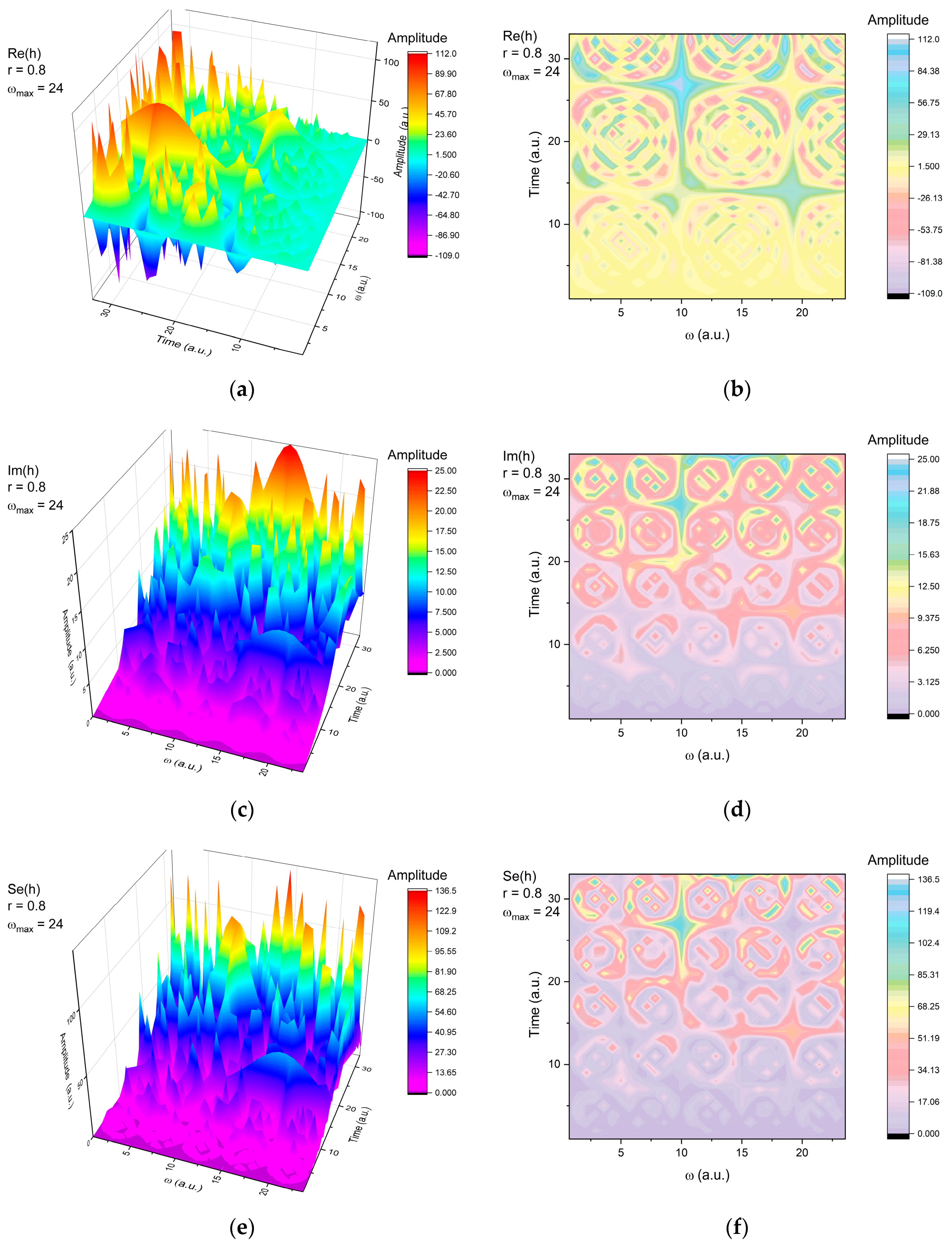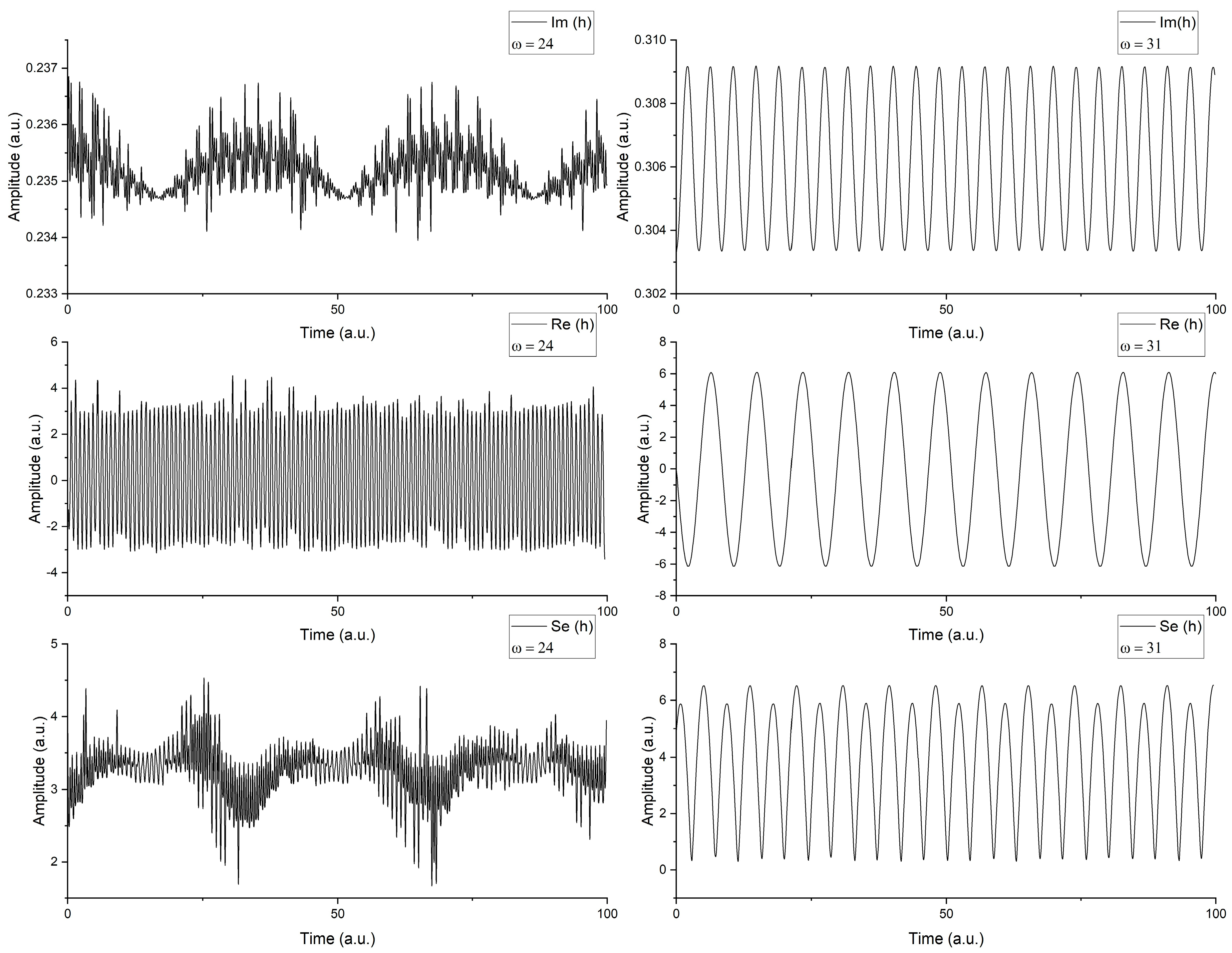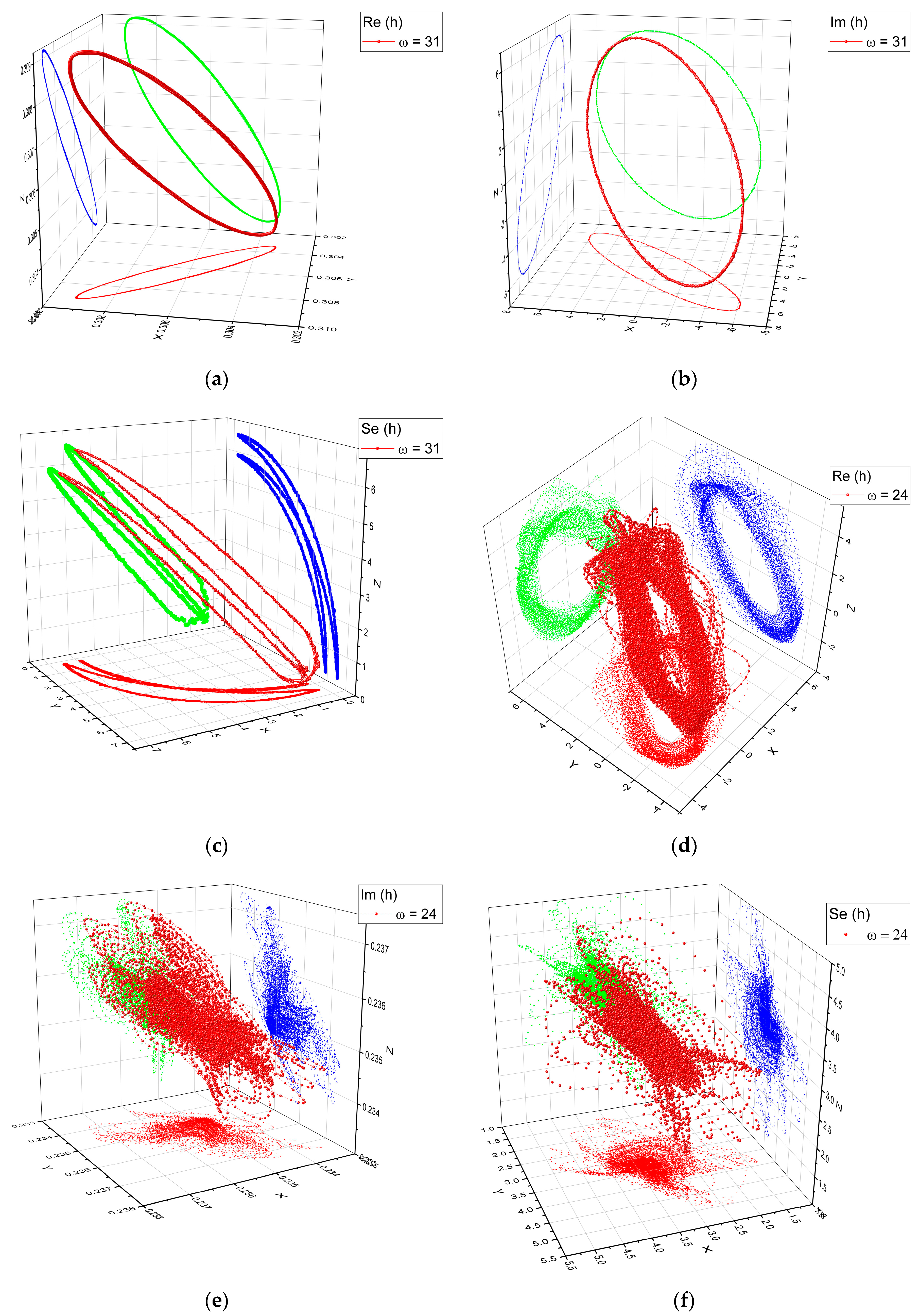Toward Interactions through Information in a Multifractal Paradigm
Abstract
1. Introduction
- (i)
- monofractal tensors of viscous stress, induced by non–differential components of velocity fields;
- (ii)
- (iii)
- harmonic mappings from the Euclidian space to hyperbolic plane through the scalar potentials of the velocity fields; and
- (iv)
- “correlation” of the kinetic moments (orbital, spin, or orbital–spin) with “pairs” generation through invariant functions of type groups.
2. Short Note on the Multifractal Theory of Motion
- (i)
- The lengths of multifractal curves tend to infinity when the scale resolution tends to zero, according to the Lebesgue theorem [3]. In these conditions, the space becomes a Mandelbrot’s multifractal.
- (ii)
- According to the substitution principle , the complex system dynamics can be corelated to a set of functions during the zoom operation of .
- (iii)
- The complex system dynamics are defined by multifractal variables. Under these conditions, two derivatives of any variable field , which describes the complex system dynamics, can be defined:The sign “” specifies the forward dynamics. The sign “” specifies the backward ones.
- (iv)
- The spatial coordinate differential has the form:does not depend on the scale resolution, while is scale resolution dependent.
- (v)
- (vi)
- To regain the differential time reflection invariance, we use the operator:This is a natural result of Cresson’s theorem [25]. For example, applying the operator (4) to yields the complex velocity fields:withIn this relation, the differential velocity is scale resolution independent, while the non-differentiable one is scale resolution dependent.
- (vii)
- (viii)
3. Dynamics in Complex Systems through Schrödinger- and Hydrodynamic-Type “Regimens” at Various Scale Resolutions
- (i)
- Any complex system’s entities are in a continuous interaction with a multifractal medium through (29);
- (ii)
- Any complex system can be identified with a multifractal fluid. In such conditions, its dynamics are described by the multifractal hydrodynamic model (Equations (26)–(28));
- (iii)
- The velocity field does not represent the contemporary dynamics. It contributes to the transfer of the specific multifractal-type momentum and to the multifractal-type energy focus. This can be easily observed from the absence of from (27) and also from its role in the multifractal variational principles (for details see [3]); and
- (iv)
- If a multifractal-type tensor is chosen:the equation defining the multifractal-type “forces” that derive from a multifractal-type “potential” can be written in the form of a multifractal-type equilibrium equation. This equation can be written in a tensorial form:whereand
4. Information and Multifractal Interactions
5. Multifractal Dynamics of a Newtonian-Type
6. Geometries Involved in Multifractal Dynamics of a Newtonian-Type
7. Conclusions
- (i)
- The specific monofractal dynamics of Nottale’s scale relativity theory were expanded to multifractal dynamics in the form of the multifractal theory of motion. Consequently, a short presentation of the non-differentiability in the multifractal theory was given.
- (ii)
- A quick overview of Shannon’s information was made (a) to define this information and its invariance regarding any transformation group; (b) from a stochastic point of view, if the variables of the transformation group are uniformly distributed, then the principle that minimizes the information is identified with that of the maximum Onicescu’s informational energy; (c) the Lagrange multipliers method is used in the minimization of information; (d) the explicitation of the information in the case of a complex system exhibiting dynamic radial symmetry is given; and (e) the correlation between Shannon’s information “subjected” to the “qualities” described in (a)–(d) and the multifractal theory of motion in its hydrodynamic form implies Newtonian-type behaviors dependent on scale resolution (i.e., interactions of a multifractal Newtonian-type).
- (iii)
- The analysis of these behaviors in the framework of the multifractal theory of motion in its hydrodynamic form involves, through a set of complex variables, motion geodesics (i.e., trajectories) with their analytic expression given by means of conics. In such a context, the result is that the center of the Newtonian-type multifractal force is different from the center of the multifractal trajectory, the measure of this difference being the eccentricity that depends on the initial conditions.
- (iv)
- The eccentricities’ geometry (the initial conditions geometry), becomes, through the Cayley–Klein metric principle, the Lobachevsky plane geometry. Then, harmonic mappings between the usual space and the Lobachevsky plane in a Poincaré metric means that the Ernst potential of general relativity becomes, in essence, of a classical nature. So, this represents a harmonic application from the usual space to the matter–field space, without making use of the concept of material structure, so necessary for the general relativity theory in Einstein’s view. Thus, a “physics” of the initial conditions “specified” by Newtonian-type multifractal motions becomes functional, to which it corresponds to a Lobachevsky geometry through the Cayley–Klein metric principle. Through this, the algebraic structure associated with these “physics” is isomorphic with the algebraic structure “dictated” by the Ernst principle upon the gravitational field in vacuum. As such, the gravitational field revealed in two separate instances—multifractal theory of motion (see (89)) and general relativity (see (91))—presents a joint group invariant of -type, which can be determined by means of Stoka’s procedure (for details see [17,21]). In such a context, the Newtonian-type multifractal dynamics perceived and described through the multifractal theory of motion become a local manifestation of the gravitational field of general relativity, as is required.
- (v)
- Several types of harmonic mappings, given by both scale resolution and temporal ordering, were graphically explained.
- (vi)
- The present theoretical model becomes applicable to any case of the existence of a real conic, being easy to demonstrate that the Cayleyan metric attached to this conic is a metric generated by the transformation group of -type, which leaves it invariant.
Author Contributions
Funding
Conflicts of Interest
References
- Nottale, L. Fractal Space-Time and Microphysics: Towards a Theory of Scale Relativity; World Scientific: Singapore; River Edge, NJ, USA, 1993. [Google Scholar]
- Nottale, L. Scale Relativity and Fractal Space-Time: A New Approach to Unifying Relativity and Quantum Mechanics; Imperial College Press: London, UK, 2011. [Google Scholar]
- Mandelbrot, B. The Fractal Geometry of Nature; W.H. Freeman and Company: New York, NY, USA, 2006. [Google Scholar]
- Politi, A.; Badii, R. Complexity: Hierarchical Structures and Scaling in Physics; Cambridge University Press: Cambridge, UK, 2003. [Google Scholar]
- Mitchell, M. Complexity: A Guided Tour; Oxford University Press: New York, NY, USA; Oxford, UK, 2011. [Google Scholar]
- Marinescu, D.C. From Classical to Quantum Information Theory; Academic: London, UK, 2011. [Google Scholar]
- Agop, M.; Gavriluţ, A.; Crumpei, G.; Doroftei, B. Informational Non-Differentiable Entropy and Uncertainty Relations in Complex Systems. Entropy 2014, 16, 6042–6058. [Google Scholar] [CrossRef]
- Agop, M.; Gavriluţ, A.; Stefan, G.; Doroftei, B. Implications of Non-Differentiable Entropy on a Space-Time Manifold. Entropy 2015, 17, 2184–2197. [Google Scholar] [CrossRef]
- Agop, M.; Gavriluţ, A.; Paun, V.P.; Filipeanu, D.; Luca, F.A.; Grecea, C.; Topliceanu, L. Fractal Information by Means of Harmonic Mappings and Some Physical Implications. Entropy 2016, 18, 160. [Google Scholar] [CrossRef]
- Grigorovici, A.; Bacaiță, E.; Păun, V.; Grecea, C.; Butuc, I.; Agop, M.; Popa, O. Pairs Generating as a Consequence of the Fractal Entropy: Theory and Applications. Entropy 2017, 19, 128. [Google Scholar] [CrossRef]
- Alipour, M.; Mohajeri, A. Onicescu information energy in terms of Shannon entropy and Fisher information densities. Mol. Phys. 2012, 110, 403–405. [Google Scholar] [CrossRef]
- Agop, M.; Gavriluţ, A.; Rezuş, E. Implications of Onicescu’s informational energy in some fundamental physical models. Int. J. Mod. Phys. B 2015, 29, 1550045. [Google Scholar] [CrossRef]
- Weinberg, S. Dreams of a Final Theory; Vintage Books: New York, NY, USA, 1994. [Google Scholar]
- Hawking, S.W.; Penrose, R. The Nature of Space and Time; Princeton Univ. Press: Princeton, NJ, USA, 1996. [Google Scholar]
- Argyris, J.; Marin, C.; Ciubotariu, C. Physics of Gravitation and the Universe; SpiruHaret: Iași, Romania; Tehnica-Info.: Chisinau, Moldova, 2002. [Google Scholar]
- Penrose, R. The Road to Reality: A Complete Guide to the Laws of the Universe; Vintage Books: New York, NY, USA, 2007. [Google Scholar]
- Agop, M.; Păun, V.P. On the New Perspectives of Fractal Theory: Fundaments and Applications; Romanian Academy Publishing House: Bucharest, Romania, 2017. [Google Scholar]
- Agop, M.; Merches, I. Operational Procedures Describing Physical Systems; Crc Press: Boca Raton, FL, USA, 2019. [Google Scholar]
- Agop, M.; Gravriluț, A.; Eva, L.; Crumpei, G. Towards the Multifractal Brain by Means of the Informational Paradigm: Fundaments and Applications; Ars Longa Publishing House: Iași, Romania, 2019. [Google Scholar]
- Gavriluţ, A.; Mercheş, I.; Agop, M. Atomicity through Fractal Measure Theory: Mathematical and Physical Fundamentals with Applications; Springer: Cham, Switzerland, 2019. [Google Scholar]
- Mazilu, N.; Agop, M.; Merches, I. Mathematical Principles of Scale Relativity Physics, Concept of Interpretation; CRC Press Taylor and Francis Group: Boca Raton, FL, USA, 2020. [Google Scholar]
- Green, S.H. Information Theory and Quantum Physics: Physical Foundations for Understanding the Conscious Process; Springer: Berlin/Heidelberg, Germany, 2000. [Google Scholar]
- Lakshmanan, M.; Rajaseekar, S. Nonlinear Dynamics Integrability, Chaos and Patterns; Springer: Cambridge, UK; Berlin/Heidelberg, Germany, 2003. [Google Scholar]
- Cristescu, C.P. Non-Linear Dynamics and Chaos: Theoretical Fundaments and Applications; Romanian Academy Publishing House: Bucharest, Romania, 2008. [Google Scholar]
- Cresson, J. Scale Calculus and the Schrödinger Equation. J. Math. Phys. 2003, 44, 4907–4938. [Google Scholar] [CrossRef]
- Dresselhaus, M.S.; Dresselhaus, G.; Jorio, A. Group Theory: Application to the Physics of Condensed Matter; Springer: New York, NY, USA, 2010. [Google Scholar]
- Arnolʹd, V.I. Mathematical Methods of Classical Mechanics; Springer: New York, NY, USA, 2010. [Google Scholar]
- Misner, C.W.; Thorne, K.S.; Wheeler, J.A. Gravitation; W.H. Freeman and Company: New York, NY, USA, 2018. [Google Scholar]
- Jaffe, R.L.; Taylor, W. The Physics of Energy; Cambridge University Press: Cambridge, UK, 2018. [Google Scholar]
- Xi, Y. Geometry of Harmonic Maps; Springer: New York, NY, USA, 2018. [Google Scholar]



© 2020 by the authors. Licensee MDPI, Basel, Switzerland. This article is an open access article distributed under the terms and conditions of the Creative Commons Attribution (CC BY) license (http://creativecommons.org/licenses/by/4.0/).
Share and Cite
Agop, M.; Gavriluț, A.; Grigoraș-Ichim, C.; Toma, Ș.; Petrescu, T.-C.; Irimiciuc, Ș.A. Toward Interactions through Information in a Multifractal Paradigm. Entropy 2020, 22, 987. https://doi.org/10.3390/e22090987
Agop M, Gavriluț A, Grigoraș-Ichim C, Toma Ș, Petrescu T-C, Irimiciuc ȘA. Toward Interactions through Information in a Multifractal Paradigm. Entropy. 2020; 22(9):987. https://doi.org/10.3390/e22090987
Chicago/Turabian StyleAgop, Maricel, Alina Gavriluț, Claudia Grigoraș-Ichim, Ștefan Toma, Tudor-Cristian Petrescu, and Ștefan Andrei Irimiciuc. 2020. "Toward Interactions through Information in a Multifractal Paradigm" Entropy 22, no. 9: 987. https://doi.org/10.3390/e22090987
APA StyleAgop, M., Gavriluț, A., Grigoraș-Ichim, C., Toma, Ș., Petrescu, T.-C., & Irimiciuc, Ș. A. (2020). Toward Interactions through Information in a Multifractal Paradigm. Entropy, 22(9), 987. https://doi.org/10.3390/e22090987








